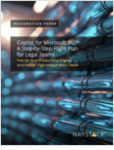One benefit of living in the digital age is that we no longer need to travel to our attorney’s office to place a wet signature on an important contract or mortgage document. Parties now regularly execute multi-million dollar real estate transactions, non-competition agreements, and stock purchases, among other agreements, using digital signature applications. The most often used application, DocuSign, boasts that its solution enables you to electronically sign while meeting the requirements of the ESIGN Act and the Uniform Electronic Transactions Act in the United States, in addition to complying with most other laws in countries where electronic signatures are recognized.
As trial lawyers who often encounter these agreements after a deal has soured, we now have an additional evidentiary burden as we lay a foundation in court and authenticate these documents which the parties “signed” digitally. As with traditional wet signatures, we can anticipate that in some instances we will need to prove that the obligee digitally “signed” the document after he or she denies doing so.
This content has been archived. It is available through our partners, LexisNexis® and Bloomberg Law.
To view this content, please continue to their sites.
Not a Lexis Subscriber?
Subscribe Now
Not a Bloomberg Law Subscriber?
Subscribe Now
LexisNexis® and Bloomberg Law are third party online distributors of the broad collection of current and archived versions of ALM's legal news publications. LexisNexis® and Bloomberg Law customers are able to access and use ALM's content, including content from the National Law Journal, The American Lawyer, Legaltech News, The New York Law Journal, and Corporate Counsel, as well as other sources of legal information.
For questions call 1-877-256-2472 or contact us at [email protected]










